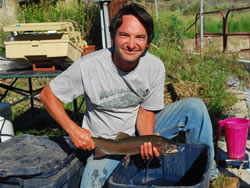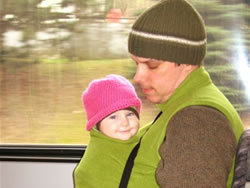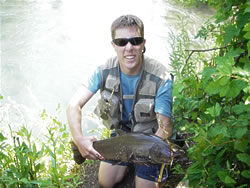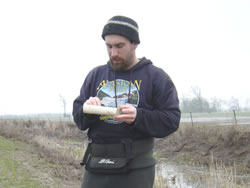Michael Scheu
M.S. Fisheries Candidate
Thesis Topic: Growth and survival of Alternative life history pathways of Juvenile Chinook Salmon in the upper John Day Basin
Recent studies indicate in the Upper John Day Basin greater numbers of sub-yearling Chinook salmon migrate early in their first summer of life to downstream nursery habitats than those that remain in the upper natal reaches. This early migrants seem to make up a majority of smolting yearlings in many years. There are many advantages for this life history to be favored by Chinook salmon in this river but it is the diversity of life histories what contributes to the stability and resilience of the population. Michael is investigating whether sub-yearling Chinook salmon that migrate early make up the largest proportion of their cohort. He is also characterizing what habitats these fish prefer and which ones offer better growth and survival conditions.
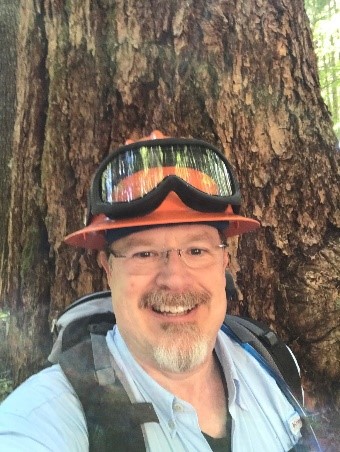
Michael Manning
(co-advisor Dr. Ivan Arismendi)
Thesis Topic: Geospatial modeling to identify factors that may influence hybridization between Bull Trout and Brook Trout
I’m interested in ecosystem characteristics that influence the distribution of aquatic species. My research will focus on how changing environmental conditions can result in the distribution overlap of native and introduced salmonid species and the potential effects on hybridization between the two. I will be using Geographic Information Systems (GIS) analysis, environmental DNA (eDNA) sampling, and stream assessments to develop models that project changes in current species distribution and the potential changes in the occurrence of hybridization that are the result of changing environmental conditions.
Masters Thesis:
Charlie Schneider
Thesis Topic: An Investigation of Stage 0 Restoration in California and Oregon
My interests have been shaped by my experiences living near the southern end of coho salmon’s range in Northern California. Many populations are of salmon and steelhead face long odds to recover to meaningful levels in California. Spending limited conservation dollars effectively and efficiently is a major goal of funders and restoration practitioners. My work looks at the efficacy of an emerging type of floodplain restoration as a potential approach to increase the scale of restoration projects while restoring ecological processes.
Charlie is now the North Coast Coordinator for Trout Unlimited in Coastal Northern California.
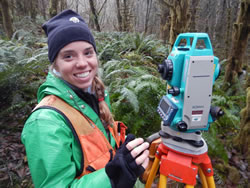
Mackenzie Baxter Butler
Thesis Topic: Relationships between hydrologic and thermal regime and Coho Salmon (Oncorhynchus kisutch) spawning in the Smith River watershed, Oregon.
Mackenzie is evaluating whether Oregon Coastal Coho Salmon returning to four tributaries of the Smith River are responding to a specific combination of water temperature and stream discharge conditions. Furthermore, as climate change continues to alter terrestrial and freshwater habitat conditions in the Oregon coast range, she will attempt to determine how the habitat conditions and the timing of Coho Salmon runs in these four sub-basins may change over time. Mackenzie is working in collaboration with Dr. Rebecca Flitcroft (USDA – Forest Service Research Lab).
Masters Thesis: The Relationship between Hydroregime and Coho Salmon (Oncorhynchus kisutch) Spawning in Three Streams of the Smith River Watershed, Oregon

Kailan Mackereth
Thesis Topic: Diet of juvenile coho salmon in stream-estuary ecotone.
Hailing from Minnesota, Kailan attended University of Wisconsin – La Crosse where she majored in Biology with a focus on environmental science. She tried her hand at chemistry-based laboratory jobs, the first as QC for a local brewery and the second in chemical manufacturing, but found that she wanted to shift her career focus towards natural resources. In 2010, Kailan made the move to Oregon where she began a post-Baccalaureate degree in BioResource Research, which introduced her to the wonderful world of aquatic entomology. Following graduation, Kailan began working for the Coos Watershed Association as the coho salmon Life Cycle Monitoring Coordinator. In addition to completing the survey responsibilities of the position at CoosWA, she incorporated her interest in aquatic entomology by examining the diet contents of juvenile coho salmon in brackish and freshwater habitats, which became the focus of her Master’s research in Dr. Giannico’s lab. Kailan is currently working for the Pacific Northwest National Laboratory in Sequim, Washington where she spent her spring in the Columbia River estuary collecting diet samples from juvenile Chinook salmon and is beginning the process of analyzing the sample contents. In her free time, Kailan enjoys camping, hiking, SCUBA diving, and having adventures.
Masters Thesis: Juvenile Coho Salmon (Oncorhynchus kisutch) Diet in Brackish and Freshwater Habitats in the Stream-estuary Ecotones of Coos Bay, Oregon

Professional Science Master’s In Fisheries and Wildlife Administration
Michael Cotter
Internship Topic: Accountability in Federally Funded Research – Implementation of the Wildlife TRACS Geospatial Database.
Michael completed his online degree in December 2014. Since 1937, over $15 billion in excise taxes have been collected and distributed to State fish and wildlife agencies to fund conservation projects and promote outdoor recreation for American sportsmen through a grant system administered through the Wildlife and Sport Fish Restoration (WSFR) Program. Program success stories and completed restoration projects have been difficult to communicate or quantify to stakeholders using antiquated, primary-key based database systems. A 2005 assessment by the Office of Management and Budget (OMB) concluded that while the WSFR program may have “…a clear purpose and design; the program needs to develop long-term outcome and output-oriented performance goals with partners.” Because the previous primary-key based WSFR database lacked an ability to illustrate accomplishments, the WSFR program and the grant programs it administers has been a target of sequestration in this age of dwindling Federal budgets. The Wildlife Tracking and Reporting Accomplishments for the Conservation of Species (TRACS) geospatial database was launched in June 2013 to provide transparency and enhance illustration of program accomplishments. As part of his internship requirements, Michael assisted in the training, design, and implementation of TRACS (Tracking and Reporting Accomplishments for the Conservation of Species), a national geospatial reporting database for the grants the Wildlife and Sports Fish Restoration (WSFR) Program administers. His internship was conducted at the U.S. Fish and Wildlife Service’s Regional Office and the U.S. Geological Survey Training Center, in Colorado. Michael facilitated a total of 7 classroom instructor-led trainings (148 students), 4 out-of-state conference trainings (60 students), 2 web-based instruction-led training (50 students), and created 13 diagrammatic web pages of best-management practices for each of the unique grant programs the WSFR program administers. A total of 45 states, 411 unique users, and 1,722 unique projects had joined or been entered in the database upon internship completion.
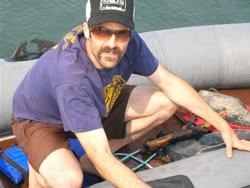
Adam Weybright
Thesis Topic: Life History of Coho Salmon (South Coast)
Adam is a native of Seattle and attended Washington State University as an undergraduate student, where he majored in Biology. He initially worked in wildlife science, conducting spotted owl surveys throughout western Washington. During the last eight years Adam has focused on fisheries science, with much of that time spent as a fisheries consultant at R2 Resource Consultants, Inc in Redmond, Washington. As a consultant, Adam participated in a variety of fisheries studies evaluating the effects of resource management on fisheries and habitat conditions. He is currently the Monitoring Coordinator at the Coos Watershed Association in Coos Bay, Oregon where he is supervising a coho salmon Life Cycle Monitoring Project to estimate juvenile and adult coho abundance and survival in two coastal lowland streams. Adam is incorporating data collected for the Coos Watershed Association into his Master’s thesis, which focuses on juvenile coho salmon movement, size and growth in tide gated lowland streams. In his limited free time, Adam hangs with his wife, Elizabeth and nearly 2 year-old son Miles, hikes, skis, and plays ultimate Frisbee.
Masters Thesis: Juvenile coho salmon movement, growth and survival in a coastal basin of southern Oregon
Juvenile coho salmon movement, growth and survival in a coastal basin of southern Oregon
Adam Weybright and Guillermo R. Giannico
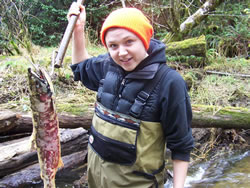
Katherine Nordholm
Thesis Topic: Use of PIT tags and otoliths microchemistry in monitoring the life cycle of coho salmon
Katherine fell in love with all things nature while she was growing up on the rural Southern Oregon Coast. She attended Southwestern Oregon Community College where she earned an Associate of Arts degree. She transferred to Oregon State University, majored in Biology and completed an option in Marine Biology. After five years working with the Oregon Department of Fish and Wildlife doing a variety of salmon monitoring research, Katherine is now working for the Coos Watershed Association as coordinator of their Coho Life Cycle Monitoring Project. Data from this project will be used in her current graduate research project in Dr. Giannico’s lab. For fun, Katherine enjoys S.C.U.B.A diving (especially spear fishing), kayaking, hiking, and an assortment of other outdoor activities with her pitbull Anna.
Masters Thesis: Contribution of subyearling estuarine migrant coho salmon (Oncorhynchus kisutch) to spawning populations on the southern Oregon coast
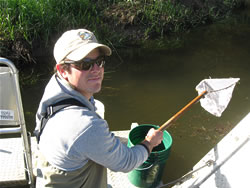
Arthur Bass
Thesis topic: Tide Gate Impacts on Juvenile Salmonids
Art Bass was born and raised in the suburban sprawl of Philadelphia, PA. He discovered nature and the outdoor world through exploration of a small creek near his home and summer time adventures with his parents. Art attended Reed College in Portland, OR where he majored in Biology and completed an undergraduate thesis focusing on bird plumage. Art worked as an ornithological researcher and for several non-profit conservation groups before beginning his masters work at OSU. In his free time Art enjoys skiing, climbing, fishing, surfing, mushroom hunting, and cooking (all in one day).
Masters Thesis: Juvenile coho salmon movement and migration through tide gates
Performance of a Full-Duplex Passive Integrated Transponder (PIT) Antenna System in Estuarine Channels
Arthur L. Bass , Guillermo R. Giannico and Gabriel T. Brooks
Matthew Anderson
Thesis Topic: Migratory Behavior and Passage of Redband Trout (Oncorhynchus mykiss) in the Donner und Blitzen River, Oregon
I have worked in the field of fisheries and watershed restoration field for about eight years now. After completing an undergraduate degree in Anthropology from the University of Arkansas, I began my current career by conducting a state-wide survey of riparian restoration projects for the Oregon Watershed Enhancement Board. Following that, I had worked for five years with the Coos Watershed Association (CoosWA). I started at the CoosWA as a biological tech conducting aquatic habitat surveys and salmon spawning surveys, but during most of my time there, I worked as a habitat restoration project manager, which involved coordinating riparian restoration, fish passage, road decommission, and in-stream habitat enhancement projects.
My Oregon State University graduate project focused on the migratory behavior and dam passage of redband trout in the Donner und Blitzen River in the high desert region of southeastern Oregon. Using radio telemetry and PIT tags, I tracked trout movement through the Malheur National Wildlife Refuge and the Steens Mountain Wilderness. The research was used to prioritize $2.2 million in fish passage restoration projects on the Wildlife Refuge. It also led to the publication of ODFW Information Report 2009-05 Migration and Passage of Redband Trout in the Donner und Blitzen River, 2007-2009.
As I was finishing my graduate studies, I accepted a position as a fish biologist on the east side of the Mt. Hood National Forest. The position involves both habitat restoration and land management on the one hand and fisheries work and monitoring on the other. During my short tenure here, I have already worked on a helicopter large wood placement, an innovative root wad bank stabilization, and road decommission projects. Among many exciting fisheries monitoring efforts, I will be working on bull trout reintroduction project in the upper Clackamas River. Although I am passionate about fish biology, I also value the importance of getting away from work. When I can, I like to spend my free time biking, rock-climbing, hiking, or kayaking. The outdoor sports motivate me to get out to see incredible places and to stay fit. I have been fortunate throughout my fisheries career to work with good people that are excited about their work and dedicated to the integrity of the resource. Thanks to all that have helped and encouraged me along the way.
Masters Thesis: Migratory behavior and passage of redband trout (Oncorhynchus mykiss) in the Donner und Blitzen River, Oregon
George Boxall
Thesis Topic: Lahontan Cuttroat Trout in Fragmented Watersheds
George D. Boxall obtained his B.A. in Biology at the University of Saint Thomas, Minnesota, and his M.S. in Fisheries Science at Oregon State University, OR. Before starting his M.S. program he had already obtained extensive experience working in the field for the USDA Forest Service, several outfitting companies in Idaho, and the Australian campus of the School for Field Studies. His love for the outdoors did not prevent him from developing his skills in the lab in areas as diverse as cell biology, microbiology, genetics, GIS and geospatial statistics.
Luis Francisco Madrinan
(co-advisor Dr. Hiram Li)
Thesis Topic: John Day River Steelhead / Redband Trout Landscape Level Integration
My investigation focuses on the causes that contribute to an increased or decreased degree of landscape fragmentation and determines their relative importance. Current metrics of landscape fragmentation need to be interpreted within the context of regional socio-economic and biophysical states to make a comparative assessment of fragmentation. Policy and land planning will be much better served by these comparative, rather than absolute, measures of fragmentation which take account of the relevant socio-economic conditions. The main task of my current project is to prepare a statistical model that predicts the degree of landscape fragmentation for regions in Europe based on physical and socio-economic characteristics of these regions.
Seth White
(co-advisor Dr. Hiram Li)
Thesis Topic: How the Animals Found Their Places: Pattern Detection, Experimentation, and Epistemology in a High Desert Stream Fish Assemblage.
My work at Columbia River Inter-Tribal Fish Commission involves determining the effect of land use and habitat restoration on freshwater Chinook salmon smolt production in the Grande Ronde basin of eastern Oregon. Most recently, I have worked as a postdoctoral research fellow in Czech Republic on issues of land use and river flow regulation from a fish conservation perspective. My Ph.D. work at Oregon State University involved gradient analysis of broad-scale fish assemblage distributions and the use of underwater video to document the “behavioral landscape” of trout and salmon in eastern Oregon wilderness streams. My M.S. work at University of Wyoming involved documenting the role of spatial adjacency of habitats and its importance for successive life history stages of cutthroat trout in Rocky Mountain watersheds. Mathematical interests include multivariate analysis of ecological data and structural equations modeling, a powerful tool for unweaving complex causal pathways among predictor variables. I have also worked extensively in outreach and science education for the public via non-technical natural history writing, photography and film, and development of watershed education workshops for the general public in Oregon, Wyoming, and Czech Republic. In my spare time, I hang out with my wife and three daughters and fish, draw, play guitar, and yodel. Just kidding, I can’t really yodel.
A ‘behaviorscape’ perspective on stream fish ecology and conservation: linking fish behavior to riverscapes
Seth M. White, Guillermo Giannico and Hiram Li
Mathew Weeber
Thesis Topic: Effects of Kokanee (Oncorhynchus nerka) Redd Superimposition on Bull Trout (Salvelinus confluentus) Reproductive Success in the Deschutes River Basin, Oregon.
Effects of Redd Superimposition by Introduced Kokanee on the Spawning Success of Native Bull Trout
M. Weeber, G. Giannico and S. Jacobs
Randall Colvin
Thesis Topic: Fish and amphibian communities use of seasonal drainages within the upper Willamette Basin, Oregon
My master’s thesis investigation involved documenting native fish communities using intermittent streams in the upper Willamette Valley, with particular focus on why these fish moved into these seasonal waterways. My post- thesis work involved working with a large group of scientists at Oregon State University investigating the overall impact of land-use, mostly grass seed production, had on the seasonal aquatic habitat of the upper Willamette basin. My particular focus was documenting the presence of native fish and amphibian communities as they related to hydrology and water quality. During my time at Oregon State, I often participated in outreach education to the farming community and the public as well as many fisheries & agricultural conferences around the state of Oregon. Currently I am serving as a visiting professor at small liberal arts college in western Georgia (Lagrange College). I am teaching a variety of courses in biology and ecology as well as serving as an advisor to students developing independent studies in aquatic ecology and zoology. Since my recent move to the southern U.S., I am learning a variety of new hobbies & experiences- some of which include – noodling, barbeque, air conditioning, home repair & did I mention barbeque?!
Masters Thesis: Fish and amphibian use of intermittent streams within the upper Willamette Basin, Oregon



